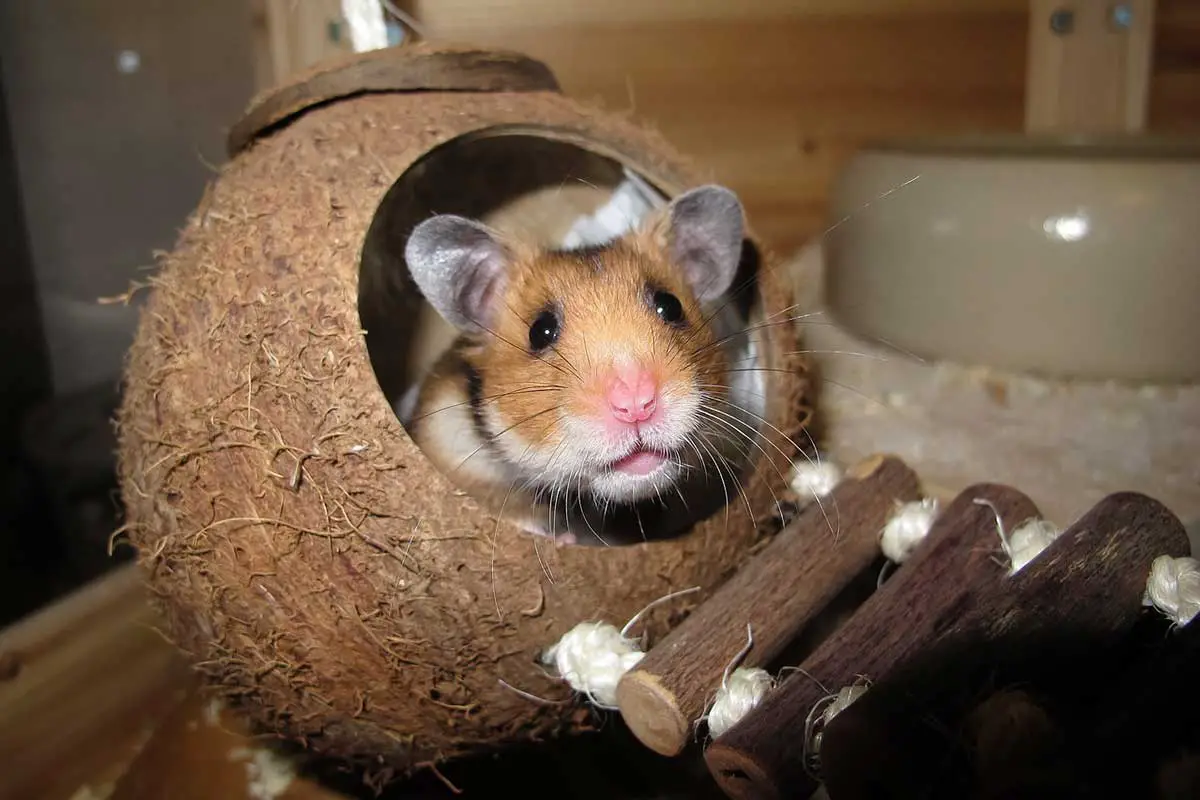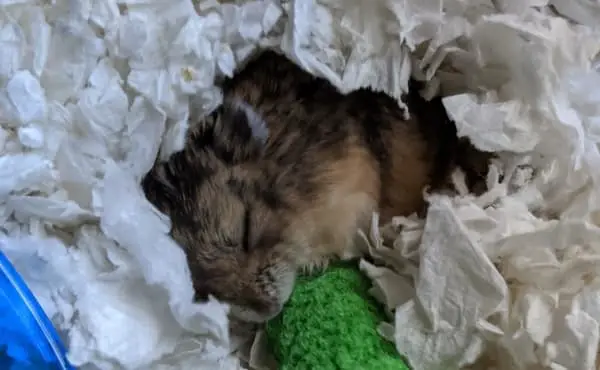Many people enjoy sharing their home with hamsters; they are adorable, they entertain us with their quirky antics, and best of all, they are relatively easy to care for. So, when something seems off about our furry friends, like their usually soft, silky fur taking on a greasy tone, it can be understandably worrisome.
So, why does my hamster’s fur look greasy? Absent any other red flags, your hamster most likely has naturally oily skin and fur. There are a few things to look out for, but if you are vigilant about your pal’s health there should be no immediate cause for concern.
This article will cover naturally oily hamsters and how to care for them, whether illness or age is causing oiliness, as well as the possibility of heat stroke, parasites, and foreign substances.
Oily by Nature
If you have noticed that your hamster’s usually luxurious and shiny coat is greasy or oily looking of late, chances are it is simply producing more natural oils from its skin than usual, which is no cause for concern.
Hamsters, just like us and any other animal, are all unique in different ways, which means some hamsters are just oilier than others. Further, while higher oil production affects some hamsters, others have more active scent glands than their counterparts, which can also account for greasy looking fur.
Hamsters have scent glands located on their flanks (sides) or bellies, depending on the breed, that they use to mark places or objects as their own, since they are naturally territorial. In dwarf breeds, scent glands are usually on the belly, while Syrian glands are located on the flanks.
Hamsters will often lick the area around their scent glands if they are excited, which could result in greasy looking fur. Further, some hamster’s scent glands are simply more active than others resulting in wet or oily patches.
Sometimes, these areas can get irritated or infected, so it is a good idea to be watchful for other signs like inflammation, redness, or reluctance to be held, which may signal that your hamster’s glands need to be checked out by a veterinarian.
While a greasy coat likely does not bother your furry friend as much as it does you, you can help prevent or get rid of it by making sure their enclosure is always clean and/or by offering a sand bath. You can make a sand bath for your friend by adding one or two inches of chinchilla or play sand (baked in the oven for about 30 minutes), into a bowl in which your pet can roll around.
Make sure you use dust-free sand in either case, as dust or debris from low quality sand can harm your companion’s respiratory system. Use a bowl made of ceramic or similar material that is heavy enough so your pet cannot topple it over while rolling, and that is not easily chewed.
While many hamsters, especially dwarf breeds, love rolling in their sand baths, some simply do not see the appeal, and still others might not even understand how to use one. If you do offer a sand bath to your furry friend, do not be dismayed if they do not immediately dive in, they will come around!
If your hamster has suddenly begun displaying signs of a greasy coat and you do not suspect it is simply oily skin or overactive glands, illness or age might be a factor.
Illness, Age, and Bugs, Oh My!
As hardy as hamsters tend to be, when they do become ill it can become serious quite quickly. This means you should always be on the lookout for signs and symptoms of illness in your little friend to ensure you catch things right away. The most common ailments for hamsters tend to be respiratory infections and digestive issues, with symptoms like these:
- Lethargy
- Decreased activity
- Huddled or hunched posture
- Sneezing, wheezing and/or discharge from the nose or eyes
- Wetness around the tail
- Diarrhea
If your companion has greasy or oily looking fur coupled with one or more of these other symptoms, you should schedule a visit with your veterinarian right away, as your pal could be suffering from anything from a cold to a condition called “wet tail,” both of which can be quite serious.
Your hamster could also be suffering from parasites such as mites, fleas, or lice. In addition to greasy or unkempt fur, look for redness and itching if you suspect parasitic stowaways.
Further still, your pal might even have ringworm which, contrary to popular belief, is not a parasite but a fungal infection. Once your companion has been treated by their veterinarian, they will be back on their tiny feet and entertaining you with their antics in no time.
Beyond illness and bugs, your pocket-sized pal might simply be getting on in years. Unfortunately, our furry friends typically only spend between two to three and a half years with us depending on the breed. This means that by the time your pal is around 18 months old, it is already “over the hill,” so to speak.
As your hamster ages, it will begin displaying signs like decreased activity, decreased mobility, and sometimes, unkempt and/or greasy looking fur. If your furry friend is entering old age, there is no need to worry about its fur, but you should try to make it as comfortable as possible so you can enjoy each other’s company in peace.
If your hamster is experiencing signs of discomfort but you do not suspect illness or age, it is time to rule out heat stroke.
The Heat Is On
Hamsters in the wild live underground in burrows consisting of intricate tunnels and multiple rooms. Their burrows can be between two and eight feet deep, depending on the breed and region, which means they are usually nice and cool in the summer and warm and cozy in the winter.
Hamsters are great at adapting to colder climes, using materials around them to pad their sleeping rooms and keep them warm. Adjusting to heat, however, is much more difficult for them, as they have little to no ability to regulate their own body temperature.
This means that hamsters, especially our domestic, air-conditioned home dwelling friends, are particularly susceptible to heat stroke.
Sometimes referred to as “sleeper disease,” heat stroke in hamsters is caused by prolonged exposure to excessive heat, either due to the environment around them being overheated or from their enclosure being placed too near a window with direct, prolonged sunlight.
Heat stroke also strikes when hamsters are left in the car, even with a window rolled down. The environment in which your hamster lives should ideally be kept dry and between 65- and 75-degrees Fahrenheit, at the most.
Signs of heat stroke include increased water intake, a sudden unwillingness to eat, wet or greasy looking fur, and extreme lethargy—meaning, your hamster is lying flat on its belly and remains limp even when you pick it up (hence the term sleeper disease).
If you suspect heat stroke, immediately cool your hamster down by misting with water or letting it lay on a cool, wet towel, and get to your veterinarian for treatment. Fortunately, if caught soon enough and treated properly, your pocket-sized pal will be feeling better before you know it.
If you have examined your hamster’s environment, determined it is not simply overly oily, and do not think illness or age are responsible for its new greasy sheen, perhaps your troublemaker just got into something it should not have.
Mischief Making
Hamsters are professional escape artists and mischief makers, so it should come as no surprise if perhaps your pal made its way out of its enclosure and into a foreign substance. In most cases, this is likely harmless, although it will mean grooming or bathing your hamster more than it would like.
Determine what it is your hamster may have gotten itself into and see if a sand bath or some grooming with a soft toothbrush can clear it up. If the substance is stubborn or potentially toxic to your pet, use a water bath as a last resort. Water baths are not safe for hamsters and usually are not recommended; however, in this case, it may be necessary for your pal’s health.
If you determine you must give your hamster a water bath, use warm water only one to two inches deep and a toothbrush or soft cloth to clean the fur.
Your hamster may panic so be patient, and dry your hamster with a warm, dry towel, holding them in it for a while afterward to calm them. Once they are completely dry, return them to a clean cage so they can have some “me” time following their ordeal.
Conclusion
If you have a hamster that has recently been sporting a greasier look than usual, chances are it is because it is either producing extra oil from its skin or has particularly active scent glands, both of which are normal. Offer a clean enclosure and a sand bath to help, but do not be surprised if your friend is not initially interested.
Your companion may be suffering from an illness, a parasitic infection, or even old age. In any case, be aware of signs and symptoms and be prepared to respond accordingly with a vet visit or some small changes for comfort.
There is a small chance your furry friend could be suffering from a heat stroke, so make sure to monitor temperature closely and get to a veterinarian if necessary. Short of these factors, your troublemaking little pal may have simply gotten into a sticky situation and needs to be bathed.
In most cases, if your hammy is happy and healthy, greasy fur is not an immediate cause for concern, so remain vigilant about your pal’s wellbeing and enjoy your time together.





